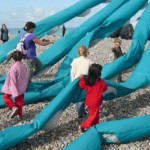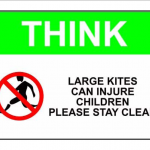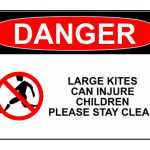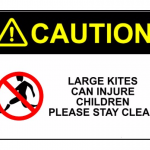
A perfect flying day for me means not having to worry about someone getting hurt. I do all I can to make sure my gear is well maintained, anchored and secure. But it is the things I can’t control that keep me awake at night. Things like kids running into bridles, kids being knocked over, or kids getting tangled and lifted in tails.
What to do about kids??
I’ve seen parents let their children do absolutely alarming things. They ignore safety boundaries. They grab lines or pull on fabric. I’ve seen baby carriages parked in bridle lines on gusty days. I’ve seen a guy on a slippery frozen lake wrap a tentacle around the neck of his child. I’ve seen swarms of children pull a Fugu apart.
And I have struggled with the right thing to say.
 “Please stay back — the kite could land or take off suddenly” just encourages young risk-takers to challenge you. Loud whistles help. And I’ve occasionally asked a kid how he would feel if I grabbed his toys without asking first.
“Please stay back — the kite could land or take off suddenly” just encourages young risk-takers to challenge you. Loud whistles help. And I’ve occasionally asked a kid how he would feel if I grabbed his toys without asking first.
Things I’ve considered but not blurted out include “I’ll just sit here on your car until your kids are done playing with my stuff.” and “If they are ‘just looking’, could I grab your wife for a ‘look’ like that too??”.
Last Spring, we were at a popular event and when the competition ended, the announcer invited the public onto “Field One”. And of course, they had no idea which field was which and flooded into our space. Thousands of them! Landing and packing up that day was scary and dangerous.
Then there was the time Susie ordered some children out of the way during a difficult launch. Their mother came and yelled at her for making the kids cry. “Better to scare them away than hurt them”, Susie replied. “Especially when a parent was no where in site.” See why I love that girl??
Twice this year, we’ve pulled down kites when field integrity was lost and flying became unsafe. Anyway, my point here is not to grumble about curious children and ignorant parents. Instead, I’m looking for some constructive tools we can use to help.
One idea we had is to add some information to the lines or tape “protecting” our flying fields. Perhaps if we explained our concerns better, people would be more responsive.
So I’ve worked up a few posters. Click on any of them from this page and you’ll get a PDF file which you can save or print out. Then tape or display the signs around your flying area.
Not sure if it will help. But can it hurt? Let me know what you think. I’ll just sit on your car and wait until we see what happens….
David Gomberg





